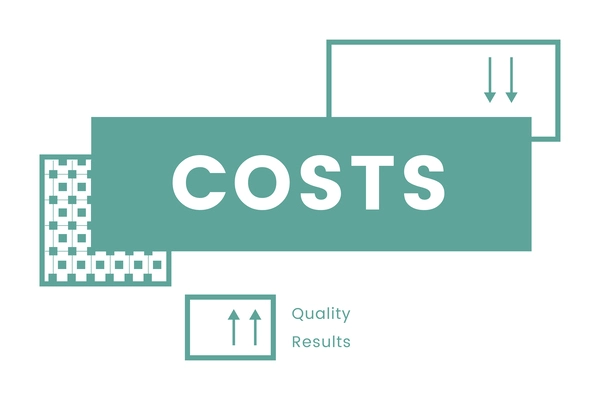In the world of business, cost-cutting is often seen as a necessary step to boost the profitability and sustainability of an organization. According to general opinion, cutting expenses does not always indicate losing quality. In this article, we will explore effective strategies to cut costs without compromising the quality of your product or service. The customers are happy, and your business is growing due to this strategy.
Analyze and Optimize Your Supply Chain
The coordination of tasks involved in producing and delivering goods and services from raw materials to the final consumer is referred to as supply chain management. This covers obtaining raw supplies, producing goods, moving them around, storing them, and delivering them. Improved customer satisfaction can result from efficient supply chain management, saving costs, and enhancing productivity.
Your supply chain can have a significant impact on your expenses. It is important to keep track of your expenses related to your supply chain. Conduct a thorough analysis to identify inefficiencies, unnecessary processes, and unnecessary costs. Smoothing your supply chain and negotiating better deals with suppliers can reduce expenses without affecting the quality of your materials or components.
Implement Lean Management Principles
The goals of lean manufacturing include efficiency improvement, lead time reduction, and waste elimination. Putting lean manufacturing practices into practice can help manufacturing companies save money, get better products, and work more efficiently.
The detection and elimination of waste in the manufacturing process is a crucial  component of lean manufacturing. This involves eliminating unnecessary movement, waiting periods, excess production, defects, over processing, and surplus inventory. Manufacturers can increase productivity and reduce costs by eliminating waste. Lean management principles focus on eliminating waste and improving efficiency in all aspects of your operations. By identifying and eliminating non-value-added activities, you can reduce costs while improving product quality. Lean principles encourage continuous improvement and empower employees to find innovative ways to cut costs without compromising quality.
component of lean manufacturing. This involves eliminating unnecessary movement, waiting periods, excess production, defects, over processing, and surplus inventory. Manufacturers can increase productivity and reduce costs by eliminating waste. Lean management principles focus on eliminating waste and improving efficiency in all aspects of your operations. By identifying and eliminating non-value-added activities, you can reduce costs while improving product quality. Lean principles encourage continuous improvement and empower employees to find innovative ways to cut costs without compromising quality.
Invest in Automation and Technology
Automation involves using technology to replace human labor. By increasing productivity, lowering labor expenses, and enhancing efficiency, automation can assist industrial companies in cutting costs.
Efficiency gains are one of the main ways that automation lowers costs. Automated equipment can complete jobs faster and more accurately than people, resulting in shorter production periods and more output. This can make it easier for firms to satisfy client demand and use fewer resources and time to perform a task.
Automation can increase efficiency and reduce labor costs without sacrificing quality. “Automated processes are usually more accurate and less prone to human errors. By investing in technology and machinery, you can maintain or even enhance product quality while reducing labor-related expenses.
Focus on Preventative Maintenance
For manufacturers, maintenance processes are essential because they support several cost-cutting measures. First and foremost, regular maintenance reduces the probability of unplanned equipment downtime, which can result in lost productivity, missed deadlines, and increased costs. This can be done by performing preventative maintenance to identify potential issues early on, as well as routinely examining and maintaining the equipment. Putting off maintenance might result in expensive breakdowns and repairs. Implement a proactive maintenance schedule to ensure that equipment and machinery operate at peak efficiency. Regular maintenance not only extends the life of your assets but also prevents costly downtime and product defects.
Reduce Energy Consumption
Manufacturing companies sometimes incur high energy expenditures since their gear and equipment need a lot of energy to operate. In fact, depending on the sector and size of the company, energy expenditures might make up as much as 30% of a manufacturer’s operational costs.
Energy expenses can have a big effect on a

manufacturing company. Energy costs that are too high can affect profit margins and make it harder for companies to compete. Additionally, f
Changing energy prices can lead to uncertainty and make it challenging to predict expenses, putting firms at risk financially. For many organizations, energy expenditures can be a considerable expense. Implement energy-efficient practices and invest in energy-saving technologies, such as LED lighting, programmable thermostats, and energy-efficient appliances. Reducing energy consumption can help you not only save costs but also show your commitment to sustainable practices.
Optimize Inventory Management
The process of controlling the movement of product from the producer to the final consumer, as well as the storing, tracking, and management of inventory levels, is referred to as inventory management. Effective inventory management is crucial for organizations to balance supply and demand, reduce expenses, and increase customer satisfaction.
Ineffective inventory control can lead to excess goods, shortages, and other inefficiencies that raise expenses. Excess inventory can result in spoilage, tie up capital, and increase storage and handling costs. On the other hand, shortages can lead to missed sales, unhappy consumers, and higher shipping and handling expenses to restock. Implement just-in-time inventory practices to keep inventory levels at a minimum while ensuring that you have the right amount of stock to meet demand without compromising quality.
Streamline Marketing and Advertising
Review your marketing and advertising strategies to identify areas where you can cut costs without sacrificing visibility or reach. Focus on digital marketing and social media, which often offer cost-effective ways to reach your target audience. Analyze the performance of different marketing channels and allocate your budget to the most effective ones.
Engage Your Employees and Train up Them
Investing in employee training can be a significant cost-saving measure for the industrial sector. Employees who have received the proper training are more effective and efficient, which increases output and lowers labor expenses.
Additionally, skilled workers are better able to understand the production process and spot opportunities for improvement.
Improved product quality can also result from training, which lowers the possibility of defects and the need for expensive recalls or rework. Overall, employee training can enhance production procedures, lower errors, and boost productivity, all of which can result in significant cost savings for a business.
Your employees can be a valuable source of cost-cutting ideas. Encourage them to participate in cost reduction initiatives and reward them for innovative suggestions. Engaged and motivated employees are more likely to find creative solutions that maintain product quality.
Continuous Quality Improvement
Measures taken to ensure that products meet or exceed the necessary quality standards are referred to as quality control measures. Implementing quality control techniques can significantly affect production costs since it decreases the number of costly faults, reworks, and returns. Manufacturers can lower the expenses of scrapping or reworking products, improve customer happiness,
 and establish a good reputation by making sure the products are created to the desired specifications and standards.
and establish a good reputation by making sure the products are created to the desired specifications and standards.
Embrace a culture of continuous quality improvement. Regularly assess your product or service quality and gather customer feedback. Use this information to make incremental improvements that enhance customer satisfaction while minimizing costs.
Cost-cutting doesn’t have to be synonymous with compromising quality. By adopting strategic cost-cutting measures, optimizing processes, investing in technology, and involving your employees in the process, you can reduce expenses while maintaining or even improving the quality of your product or service. Remember that quality should always remain a top priority, and cost-cutting strategies should complement, not undermine, that commitment.

